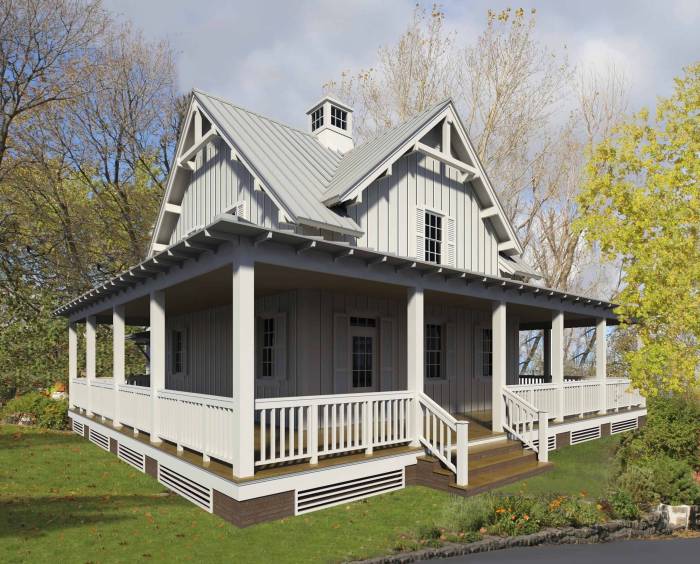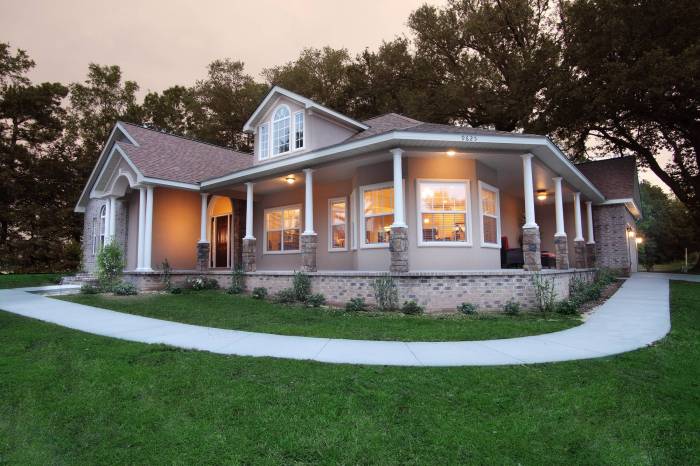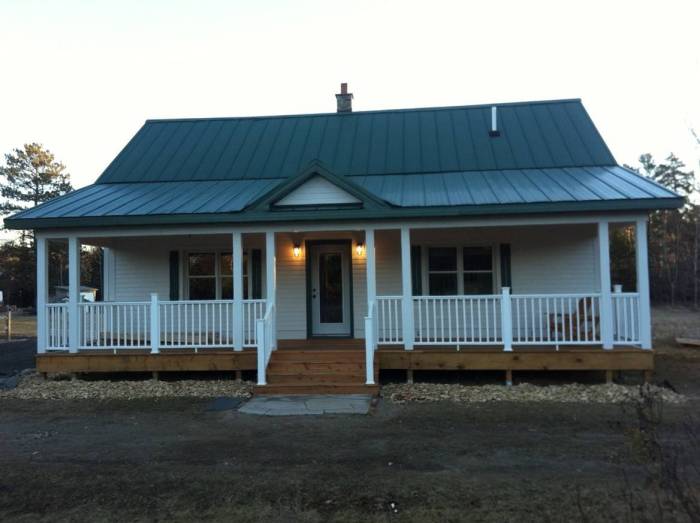Envision the allure of a sprawling wrap-around porch, beckoning you to unwind and savor the beauty of your surroundings. Modular homes, with their inherent versatility and adaptability, provide an exceptional canvas upon which to craft this architectural dream. This comprehensive guide delves into the world of modular homes adorned with wrap-around porches, exploring their advantages, design considerations, construction methods, and more.
Prepare to be captivated by the endless possibilities that await you in this realm of comfort and curb appeal.
From the moment you step onto the porch, you’ll be greeted by a sense of tranquility and connection to nature. Whether you’re sipping your morning coffee while watching the sunrise or hosting a summer gathering with friends and family, the wrap-around porch seamlessly extends your living space, creating an idyllic outdoor oasis.
Its expansive design invites you to embrace the outdoors while providing ample shade and shelter from the elements.
Modular Construction Overview
Modular construction, also known as prefabricated construction, involves assembling pre-built sections or modules of a structure in a factory setting before transporting them to the building site for final assembly. This approach offers numerous advantages and presents certain disadvantages compared to traditional on-site construction methods.
Advantages of Modular Homes:
- Faster Construction: Modular homes can be constructed significantly faster than traditional homes as the modules are built simultaneously in a controlled factory environment, allowing for efficient workflow and reduced weather delays.
- Cost-effectiveness: Modular construction often offers cost savings compared to on-site construction due to economies of scale, optimized material usage, and reduced labor costs.
- Improved Quality: Factory-controlled conditions and stringent quality control measures ensure consistent and high-quality construction, minimizing defects and potential construction issues.
- Sustainability: Modular construction promotes sustainability by reducing waste and minimizing the environmental impact of construction activities compared to traditional methods.
- Design Flexibility: While modular homes are often associated with standardized designs, they offer a wide range of customization options, allowing homeowners to tailor their homes to their specific preferences.
Disadvantages of Modular Homes:
- Transportation Limitations: The size and weight of modular sections may impose limitations on transportation, especially in areas with challenging terrain or limited access.
- Site Restrictions: The assembly of modular homes requires a suitable building site with adequate space and accessibility for the transportation and placement of modules.
- Design Constraints: Modular homes may have some design constraints compared to traditional construction methods due to the need to adhere to module dimensions and transportation limitations.
- Potential Delays: Delays can occur during the factory production or transportation stages, which may impact the overall construction timeline.
- Perceived Value: Some potential buyers may perceive modular homes as less valuable compared to traditional homes, which can affect resale value.
Wrap-Around Porch Design
A wrap-around porch is a stunning addition to any modular home, offering a spacious and inviting outdoor living space. It encircles at least two sides of the home, providing panoramic views of the surrounding landscape.The benefits of a wrap-around porch are numerous.
It extends the living space outdoors, creating a seamless transition between the interior and exterior. It provides ample space for relaxation, entertaining guests, and enjoying the fresh air. Additionally, it adds architectural interest and curb appeal to the home.There are various wrap-around porch designs to choose from.
The most common is the full wrap-around porch, which extends around three or more sides of the home. A partial wrap-around porch covers only two sides of the home. A screened wrap-around porch offers protection from insects while still allowing for ventilation.When
choosing a wrap-around porch for a modular home, consider the size and style of the home, as well as the desired functionality. A larger home can accommodate a full wrap-around porch, while a smaller home may be better suited for a partial wrap-around porch.
The porch design should complement the architectural style of the home, whether it be traditional, modern, or rustic.
Materials
Wrap-around porches can be constructed from various materials, including wood, vinyl, and composite. Wood is a classic choice, offering warmth and natural beauty. Vinyl is a low-maintenance option that is resistant to rot and decay. Composite materials combine the durability of vinyl with the look of wood.
Features
Consider adding features to enhance the functionality and aesthetics of the wrap-around porch. These may include ceiling fans for ventilation, lighting for evening use, and built-in seating for comfortable relaxation.
Design Considerations
Integrating a wrap-around porch seamlessly into your home’s design requires careful consideration of architectural styles and thoughtful planning. Explore the various architectural styles that complement wrap-around porches, and discover tips for maximizing their functionality and aesthetic appeal.
Architectural Styles
Wrap-around porches are versatile design elements that can enhance a wide range of architectural styles. Traditional styles such as Victorian, Craftsman, and Farmhouse incorporate wrap-around porches as a central feature, while modern styles like Contemporary and Mid-Century Modern embrace them for their spaciousness and connection to the outdoors.
Incorporating into Home Design
To effectively incorporate a wrap-around porch into your home’s design, consider the following:
- Placement: Position the porch on the side of the house facing the best views or natural light.
- Size: Determine the appropriate size for the porch, ensuring it complements the scale of the house and provides ample space for furniture and activities.
- Access: Plan for convenient access to the porch from multiple rooms in the house.
- Roofline: Choose a roofline that harmonizes with the architectural style of the house and provides adequate coverage for the porch.
Maximizing Functionality and Appeal
To maximize the functionality and aesthetic appeal of your wrap-around porch, consider these tips:
- Outdoor Living: Equip the porch with comfortable seating, lighting, and a fire pit or grill to create an inviting outdoor living space.
- Storage: Incorporate built-in storage benches or cabinets to keep cushions, blankets, and other items organized.
- Landscaping: Enhance the porch’s appeal with lush landscaping, adding greenery, flowers, and trellises for privacy.
- Decorative Elements: Personalize the porch with decorative elements such as hanging plants, lanterns, and wind chimes.
Construction Methods
Modular homes with wrap-around porches can be constructed using various methods, each with its advantages and challenges.Innovative construction techniques include using prefabricated panels, which are built off-site and assembled on-site, reducing construction time and labor costs. Another technique is using modular steel frames, which provide a lightweight and durable structure that can be easily customized.
Challenges and Solutions
Constructing modular homes with wrap-around porches presents unique challenges, such as ensuring the porch’s structural integrity and stability. Solutions include using reinforced framing and support beams to handle the additional weight and wind loads. Proper drainage systems are also crucial to prevent water damage to the porch and foundation.
Materials and Finishes
The materials used for wrap-around porches vary depending on the desired style, budget, and climate. Each material offers unique advantages and disadvantages, so it’s crucial to choose wisely to ensure durability and weather resistance.
Wood
- Advantages: Natural beauty, warmth, and versatility; easy to customize and repair.
- Disadvantages: Requires regular maintenance (staining, painting), susceptible to rot and insect damage.
Composite Decking
- Advantages: Low maintenance, durable, resistant to rot and insects; available in various colors and textures.
- Disadvantages: Can be more expensive than wood, may fade over time.
Vinyl
- Advantages: Extremely low maintenance, waterproof, and fade-resistant.
- Disadvantages: Limited design options, can appear artificial.
Aluminum
- Advantages: Lightweight, durable, fire-resistant, and virtually maintenance-free.
- Disadvantages: Can be more expensive than other materials, may dent or scratch.
Cost Considerations
The cost of a modular home with a wrap-around porch can vary depending on several factors, including the size and complexity of the home, the materials used, and the construction methods employed.
Here is a breakdown of the typical cost ranges for different types of materials and construction methods:
Materials
- Wood: $100-$200 per square foot
- Vinyl: $80-$120 per square foot
- Fiber cement: $120-$180 per square foot
- Stone: $150-$250 per square foot
Construction Methods
- Stick-built: $150-$250 per square foot
- Modular: $120-$180 per square foot
- Panelized: $130-$200 per square foot
Ways to Save Money
There are several ways to save money on the construction of a modular home with a wrap-around porch:
- Choose a smaller home: The smaller the home, the less it will cost to build.
- Choose less expensive materials: Wood and vinyl are less expensive than fiber cement and stone.
- Use a modular construction method: Modular homes are typically less expensive to build than stick-built homes.
- Do some of the work yourself: If you have the skills, you can save money by doing some of the work yourself, such as painting or installing flooring.
Case Studies
Modular home projects with wrap-around porches have gained popularity due to their aesthetic appeal and functionality. Several successful projects showcase the benefits of this design.
Challenges and Solutions
During construction, challenges arise in coordinating the delivery and assembly of modular units, ensuring weatherproofing at joints, and maintaining structural integrity. These challenges are overcome with meticulous planning, precise execution, and innovative techniques.
Aesthetic Appeal and Functionality
Wrap-around porches enhance the curb appeal of modular homes, creating a welcoming and inviting atmosphere. They provide additional outdoor living space, extending the living area and connecting it to the surrounding environment. The porches offer protection from the elements while allowing natural light and ventilation.
Last Recap
As you embark on your journey to create a modular home with a wrap-around porch, remember that it’s not merely a structural addition but an investment in your lifestyle. It’s a space where memories are made, where you can escape the hustle and bustle of daily life, and where you can truly connect with your surroundings.
Whether you opt for a classic Victorian-inspired design or a contemporary masterpiece, the wrap-around porch will undoubtedly become the heart of your home, a cherished gathering place that enhances your everyday living experience.



